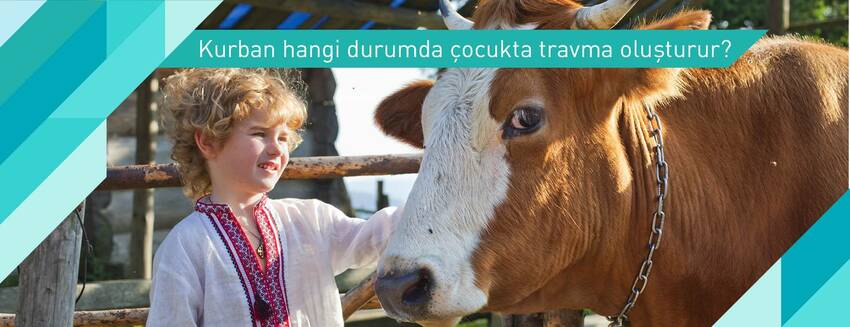Contents
In which situation does sacrifice traumatize a child?
Stating that children's abstract thinking skills develop by the age of 12, experts draw attention to the fact that watching the sacrifice of children under this age will have a traumatizing effect.
Stating that the beautiful aspects of the holidays that bring the society together can be explained to children, experts said, "We should explain the concepts of sharing and solidarity, which we experience very concretely, especially on the Feast of Sacrifice."
Üsküdar University NPISTANBUL Hospital Specialist Psychologist Duygu Barlas pointed out that abstract thinking ability develops from the age of 12 and said that young children may be affected by the sacrifice. Barlas spoke as follows:
SACRIFICE FEAST IS AN OPPORTUNITY TO LEAVE DIFFICULT DAYS BEHIND!
"New clothes on Eid, the pocket money they collect, the Eid tables where they come together with their loved ones are beautiful memories that children always remember when they grow up. However, there are some points to be considered during Eid al-Adha. Especially if we consider the recent period of our country, there have been events that can be called traumatic for all of us. These events have affected our children as much as adults. Eid al-Adha should be considered as an opportunity to leave these difficult days behind. We should spend Eid al-Adha in happiness and peace, come together with our loved ones and share emotionally. Families and adults should pay attention to some points so that children do not experience a new trauma due to sacrifice and have a healthy holiday.
HOW TO EXPLAIN EID AL-ADHA TO CHILDREN?
Explaining Eid al-Adha to children is very important. By the age of 12, children begin to develop abstract thinking abilities. In other words, before the age of 12, a child comprehends many things instantly and through concrete objects, and very little abstract thinking ability has developed. Although the end of the story of Eid al-Adha makes sense to us adults, to a child under the age of 12, the abstract subjects of death and sacrifice may seem meaningless and sometimes frightening.
THE MEANING OF EID AL-ADHA SHOULD BE EXPLAINED
Therefore, children of this age should be told about the meaning of the holiday in general. The aspects of the Feast of Sacrifice, which allows people to help each other, especially the distribution of meat, sharing and making many aids together, strengthening unity and solidarity, should be mentioned. Thus, the social and cultural consequences of the feast will be conveyed, which will contribute to the child's understanding of the feast. For children aged 12 and above, the child's emotional maturity and ability to grasp abstract subjects should be taken into consideration."
HOW IS THE CHILD AFFECTED?
Duygu Barlas pointed out that if Eid al-Adha is not explained in accordance with the child's age, emotional maturity and abstract thinking skills, it may cause some problems and listed these negativities as follows:
- Since abstract thinking is weak for the child, he/she may perceive the story as concrete and this situation may seem scary to the child, he/she may be confused and may have difficulty controlling his/her fear.
- With uncontrollable fears, children's sleep patterns may be disrupted, their appetite may be unbalanced, fearful dreams and anxiety disorders may occur.
- On the one hand, instilling in children the love of animals and not harming them, and on the other hand, witnessing a slaughter can lead to a serious contradiction in children. In particular, the common custom of smearing the blood of the sacrificed animal on the child's forehead can be as traumatizing as witnessing the slaughter.
- If the child has a pet animal at home, he/she may develop fears about whether it will also be sacrificed. Again, if the child cannot control this fear, problems such as anxiety and sleep disorders may arise.
What should be considered to prevent children from being traumatized?
Duygu Barlas stated that important points should be taken into consideration in order to prevent an event that brings beauties such as Eid from causing trauma in children and made the following recommendations:
- First of all, an age-appropriate explanation should be made.
- The sacrifice should be done in a suitable place and under appropriate conditions. Children should not witness this slaughter. If the child insistently asks whether the animal to be sacrificed is suffering or not, the conditions under which the process will be carried out can be briefly explained to him/her.
- During Eid al-Adha, unhealthy slaughter conditions and escaped victims are frequently in the news. Keep your children away from such news whenever possible.
- Avoid talking to children about slaughtering, blood or similar topics. Instead, focus on the other beauties of the holiday and convey these to your child.
- Do not force your child to watch the sacrifice by calling it tradition and culture. Remember that our tradition and culture is not only about the slaughter, but also about many other social factors.
- Avoid jokes about the slaughter or sacrifice, and try to prevent them from being made in the presence of your child.
WHAT SHOULD BE DONE IF THE CHILD WITNESSES THE SLAUGHTER?
Duygu Barlas also listed the things to do if the child sees the sacrifice despite the precautions taken as follows:
"First, listen to your child without explaining to him/her; try to understand where, with whom and how he/she saw the slaughter. After your child tells you, indicate that you understand him/her. Do not criticize, judge or make fun of him/her. Let your child express his/her fear, sadness or anxiety. Let the child also express his/her thoughts about the event and if there are any thoughts that may have caused the challenging emotion, please talk about them too. If the child's anxiety does not subside after the event, if there is still an imbalance in sleep and appetite, it may be necessary to seek help from a professional."

